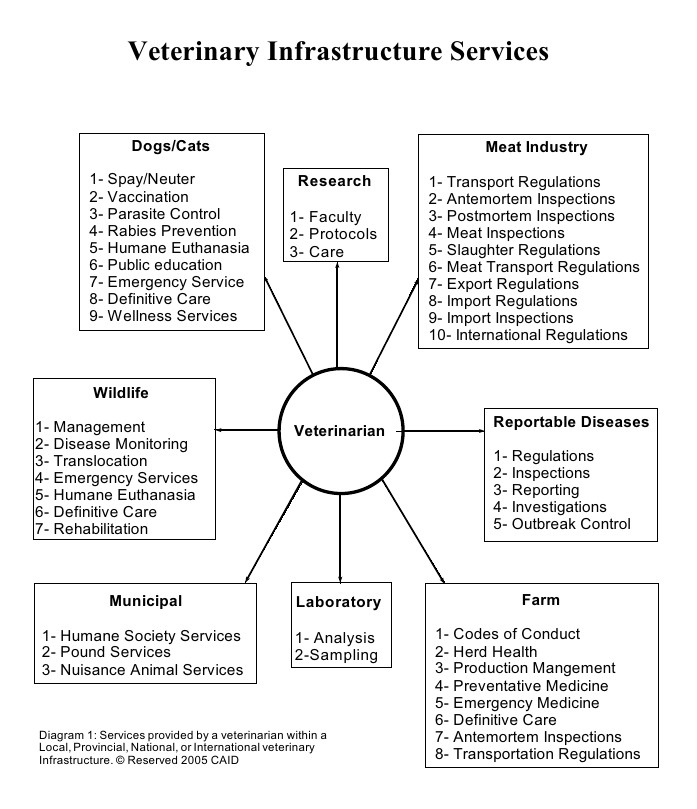Introduction to Veterinary Infrastructure
There are approximately 15,000 veterinarians in Canada involved in a veterinary infrastructure at local, provincial, territorial or federal levels. Services provided by the veterinarian infrastructure create:
- Protocols through which legislation and regulation become regional, national and international meat and fish industries;
- Animal care and disease management strategies to ensure animals, people, animal food products, and animal by-products are kept safe from abuse and disease; and,
- Foundations upon which humane societies and communities manage dog populations.
Services provided by veterinarians (see Diagram 1) create an enormous global veterinary infrastructure. In essence, veterinarians are involved with every species of domestic and wild animal for the development and implementation of their health, management, inspection, regulation, use, transport, slaughter, care and consumption.

Unfortunately, Indigenous Peoples do not have a veterinary infrastructure to replace or harmonize with existing provincial and federal veterinary infrastructure services. The root origin of this infrastructure void arises from the exclusion of Indigenous Peoples from provincial and territorial veterinary-related legislation, regulations and services. As such, there are recurrent public health crises caused by unsafe food, out-of-control dog populations, and nuisance wildlife in Indigenous communities. Further, Indigenous people are prevented from developing a sustainable traditional economy based on the trade of inspected, safe traditional food (wild meat and fish) - a country food infrastructure.
Services supplied by veterinarians considered to be part of a nation’s core food and community infrastructures involve:
- Maintaining quality disease and toxin-free meat and fish supplies;
- Wild and farmed animal health management;
- Zoonotic disease prevention (Examples include: Rabies, tuberculosis, salmonellosis, toxoplasmosis, scabies, cryptococcosis, psittacosis, campylobacteriosis, yersiniosis, leptospirosis, brucellosis, echinococcosis, visceral larval migrans, strongyloidiasis, giardiasis, trichinosis, blastomycosis, tularaemia, and etc.);
- Nuisance or over-populated wildlife control;
- Companion animal (dogs and cats) population management; and,
- Prevention of animal suffering.
Canada’s Indigenous Peoples have a right to develop their own traditional country food infrastructure and access the same public health solutions for their communities as non-native Canadians. This includes the development of missing Indigenous veterinary infrastructure and its: (1) wild meat and fish industries, (2) wild animal health monitoring systems and (3) dog control/management solutions.
- Wild meat and fish industries;
- Wild animal health monitoring systems; and,
- Dog control/management solutions.
© Christian Aboriginal Infrastructure Developments
 Follow
Follow